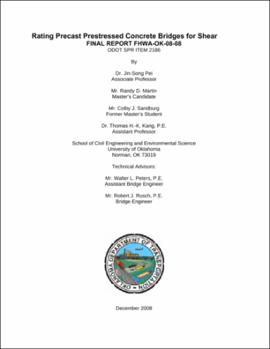| dc.creator | Pei, J.S. | |
| dc.creator | Martin, R.D. | |
| dc.creator | Sandburg,C.G. | |
| dc.creator | Kang, T.H.-K. | |
| dc.date.accessioned | 2018-04-20T22:47:29Z | |
| dc.date.available | 2018-04-20T22:47:29Z | |
| dc.date.issued | 2008-12 | |
| dc.identifier.govdoc | FHWA-OK-08-08 | |
| dc.identifier.other | Oklahoma Department of Transportation State Planning and Research item number 2186 | |
| dc.identifier.uri | https://hdl.handle.net/11244/299501 | |
| dc.description.abstract | Shear capacity of real-world prestressed concrete girders designed in the 1960’s and 1970’s is a concern because AASHTO Standard Specifications (AASHTO-STD) employed the quarter-point rule for shear design, which is less conservative for shear demands than today's AASHTO LRFD. Shear tests were conducted on two full sized AASHTO Type II girders, one of which had been in service for nearly forty years before being replaced due to irreparable damage. The comparison of nominal shear capacities according to the 11th Edition AASHTO-STD (1973), AASHTO LRFD (2004), ACI 318-08 including provisions for strut and tie models is carried out. By examining the ratios of nominal shear capacity to demands for each code, considering all load and resistance factors, these code-to-code comparisons are better able to identify girders that may be deficient according to today's standards than a direct comparison of nominal capacities alone. Experimental results for shear capacity of real-world girders are compared with the codes' nominal capacities to check if the girders' are structurally sufficient. Additionally, LRFR is used to check the statistical safety for AASHTO inventory and legal loads. Preliminary results are presented on the estimation of effective prestressing force using static test data. Nominal shear capacity is particularly sensitive to effective prestressing force under current design codes, so it's important to have accurate values when making calculations. In attempt to get more accurate results for effective prestressing force, span varying flexural stiffness is assumed. This assumption reflects that girders with long histories may be damaged, obvious or otherwise. Inverse problems are formulated where input and output are measured to determine system properties. Key challenges are discussed, and future work is identified. For a given girder, the ratio of nominal shear capacity to demands has generally decreased with newer codes. Girders having this ratio near one for the 11th Edition AASHTO-STD may be structurally deficient according to newer codes, however, LRFR results show that the girders in this study are safe for all AASHTO legal loads. Experimental results indicate that the girders’ actual capacity exceeds nominal capacity of current codes. Additional shear capacity t ests should be performed on more real-world girders to get a more definitive conclusion. | |
| dc.format.extent | 118 pages | |
| dc.format.extent | 9,629,117 bytes | |
| dc.format.medium | application.pdf | |
| dc.language | en_US | |
| dc.relation.ispartofseries | No | |
| dc.relation.requires | Adobe Acrobat Reader | |
| dc.relation.uri | http://www.okladot.state.ok.us/hqdiv/p-r-div/spr-rip/library/reports/fhwa-ok0808.pdf | |
| dc.title | Rating Precast Prestressed Concrete Bridges for Shear (FHWA-OK-08-08 2186) | |
| dc.type | Technical Report | |
| dc.description.version | Final Report, October 2005-December 2008 | |
| dc.description.peerreview | No | |
| dc.type.material | text | |
| dc.subject.keywords | Prestressed concrete | |
| dc.subject.keywords | shear capacity | |
| dc.subject.keywords | quart-point rule | |
| dc.subject.keywords | code comparison | |
| dc.subject.keywords | testing & inverse problem of aging girder | |
| dc.contributor.sponsor | Oklahoma Department of Transportation. Materials and Research Division. Office of Research & Implementation | |
